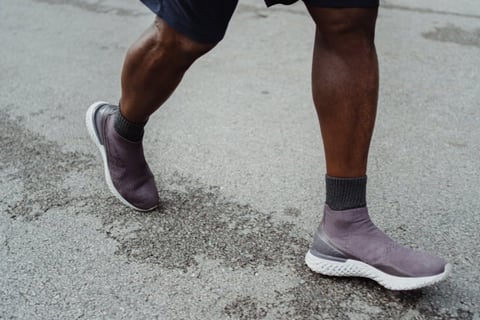CREATE YOUR OWN WEBSITE WITHIN 2 MINUTES USING AI WITH 20% OFF TODAY WITH HOSTINGER! 👉CLICK HERE!
Walking 10,000 Steps Weight Loss Results: The Complete Guide
In a world of complex diet plans and intense workout regimens, something as simple as walking might seem too basic to be effective. Yet the humble act of putting one foot in front of the other has transformed countless lives in the weight loss journey. The famous "10,000 steps a day" goal has become a fitness benchmark for many. But does it really work for weight loss? How much weight can you actually lose? And how long does it take to see results?
LOSING WEIGHT EASILY
Philip DEVILLE
3/20/202514 min read


Walking 10,000 Steps Weight Loss Results: The Complete Guide
In a world of complex diet plans and intense workout regimens, something as simple as walking might seem too basic to be effective. Yet the humble act of putting one foot in front of the other has transformed countless lives in the weight loss journey. The famous "10,000 steps a day" goal has become a fitness benchmark for many. But does it really work for weight loss? How much weight can you actually lose? And how long does it take to see results?
This comprehensive guide dives into the real results people achieve when committing to 10,000 daily steps. I'll share evidence-based expectations, timeline projections, and practical strategies to maximize your walking for weight loss success. Whether you're just starting your fitness journey or looking to break through a plateau, this walking guide will give you the roadmap you need.
The Origin of the 10,000 Steps Goal
The 10,000 steps target wasn't born from scientific research as many assume. It actually emerged from a 1960s Japanese marketing campaign for one of the first pedometers called "Manpo-kei," which translates to "10,000 steps meter." The number was chosen partly because the Japanese character for 10,000 resembles a person walking.
Despite its commercial origins, subsequent research has validated that this benchmark sits in a sweet spot for health benefits. It's roughly equivalent to walking about 5 miles or 8 kilometers daily, depending on your stride length. For most sedentary people, this represents a significant increase in physical activity without being unattainable.
The average American walks only 3,000-4,000 steps per day. This gap between typical behavior and the 10,000-step goal creates enough of a calorie deficit to potentially drive meaningful weight loss results.
🔥 Rewire Your Mind, Melt Fat FAST – For FREE! 🔥 Unlock the power of Limitless NLP to crush cravings, stay motivated, and achieve effortless weight loss! 🚀 Tap into your subconscious and watch the fat disappear! 💥 GRAB it NOW for FREE! ⬇️👇
The Basic Math: Calories Burned While Walking
Weight loss fundamentally comes down to creating a calorie deficit. Walking 10,000 steps burns approximately:
300-400 calories for a 150-pound person
400-500 calories for a 180-pound person
500-600 calories for a 200-pound person
These numbers vary based on:
Walking speed
Terrain (flat vs. hills)
Your fitness level
Body composition
Age
In theory, if you create a daily deficit of 500 calories through walking alone, you could lose about 1 pound per week (since 3,500 calories equals roughly 1 pound of fat). This simple math suggests that walking 10,000 steps daily could lead to 4-5 pounds of weight loss per month.
But real-world results are more complex and individual. Let's look at what science and real people's experiences tell us.
Scientific Evidence: Walking and Weight Loss
Multiple studies support walking as an effective weight loss strategy:
The American College of Sports Medicine found that moderate-intensity walking for 150-250 minutes per week (about 7,500-12,500 steps daily) prevented weight gain in most adults. When increased to 250+ minutes weekly with moderate diet changes, it led to significant weight loss.
A 2019 JAMA Internal Medicine study followed 94 women for 12 months. Those averaging 10,000 steps daily lost an average of 10 pounds more than those walking 3,000 steps.
A 2020 British Journal of Sports Medicine review analyzing 14 studies and 1,800+ participants found that walking interventions resulted in an average weight loss of 3-7 pounds over 8-16 weeks, with higher step counts correlating with greater results.
The science is clear: consistent walking at the 10,000-step level can drive meaningful weight loss, especially when combined with proper nutrition.
🔥 Rewire Your Mind, Melt Fat FAST – For FREE! 🔥 Unlock the power of Limitless NLP to crush cravings, stay motivated, and achieve effortless weight loss! 🚀 Tap into your subconscious and watch the fat disappear! 💥 Download it NOW for FREE! ⬇️👇
The Timeline: Realistic Weight Loss Results from Walking
When embarking on a 10,000 steps challenge, understanding the typical timeline helps set realistic expectations. Here's what most people experience:
First Two Weeks (Days 1-14)
Most people see an initial drop of 1-3 pounds, often from:
Water weight reduction
Decreased bloating
Lower inflammation
You'll likely notice:
Improved energy levels
Better sleep quality
Reduced stress
Looser-fitting clothes
This period is critical for habit formation. Your body is adapting to the increased activity level.
First Month (Days 15-30)
By the one-month mark, more substantial changes occur:
Weight loss of 2-5 pounds total
Noticeable improvements in mood
Enhanced endurance
Reduced cravings for sugary foods
Your walking pace naturally increases as fitness improves, burning more calories during the same activity.
Months 2-3 (Days 31-90)
This period typically shows:
Steady weight loss of 1-2 pounds per week
Visible body composition changes
Improved cardiovascular fitness
Better metabolic markers
By the three-month mark, those consistently hitting 10,000 steps daily often report total weight loss of 8-15 pounds.
Beyond 3 Months
Long-term walkers experience:
Continued gradual weight loss
Significant improvements in cardiovascular health
Reduced risk factors for chronic diseases
Better joint mobility
Mental health benefits
Many people find they naturally incorporate more movement throughout their day, further enhancing results.
🔥 Rewire Your Mind, Melt Fat FAST – For FREE! 🔥 Unlock the power of Limitless NLP to crush cravings, stay motivated, and achieve effortless weight loss! 🚀 Tap into your subconscious and watch the fat disappear! 💥 GRAB It for FREE Here!⬇️👇
Real People, Real Results: Walking Success Stories
The numbers from studies are informative, but real-life examples bring the potential to life:
Sarah, 42, administrative assistant: "I started with just 5,000 steps and worked up to 10,000 over three weeks. In six months, I lost 27 pounds without changing my diet much. The first month was slow—only 4 pounds—but then it became more consistent. Walking became my 'me time' to process the day."
Marcus, 55, accountant: "After my doctor warned me about pre-diabetes, I committed to 10,000 steps daily. I lost 18 pounds in 4 months. The biggest surprise was how it improved my blood sugar levels. I couldn't believe something so simple could be so effective."
Jennifer, 38, teacher: "As a busy mom of three, finding time to exercise seemed impossible. I started walking during my lunch break and after dinner with the kids. In the first month, I only lost 2 pounds and almost quit. But by month three, I was down 11 pounds and my energy was through the roof. I'm now down 35 pounds after a year."
David, 61, retired: "Walking saved my retirement. I was overweight and had knee pain that limited my activities. Starting with just 6,000 steps, I worked up to 12,000 daily. I've lost 42 pounds over 14 months, and my knee pain is gone. I wish I'd started sooner."
These stories highlight important patterns:
Initial results vary widely
Consistency matters more than intensity
Benefits extend far beyond weight loss
Combining walking with modest nutrition changes amplifies results
How to Maximize Fat Loss from Walking
To optimize your walking for weight loss results, incorporate these evidence-based strategies:
Optimal Walking Pace
Research suggests that a moderately brisk pace of 3-4 mph (100-120 steps per minute) hits the sweet spot for fat burning. At this speed:
You can still hold a conversation
You're slightly breathless
Your heart rate reaches 60-70% of maximum
This intensity activates fat-burning mechanisms while remaining sustainable for longer durations. Walking too slowly reduces calorie burn, while walking too fast may cut your workout time short due to fatigue.
Strategic Timing
Fasted morning walks can increase fat utilization. A 2019 British Journal of Nutrition study found that walking before breakfast can burn up to 20% more fat than walking after eating.
After-meal walks (even short 10-minute strolls) help manage blood sugar and reduce fat storage. An evening walk can also curb nighttime snacking habits.
Breaking up walks throughout the day appears more effective than one long session for both metabolic health and adherence.
🔥 Rewire Your Mind, Melt Fat FAST – For FREE! 🔥 Unlock the power of Limitless NLP to crush cravings, stay motivated, and achieve effortless weight loss! 🚀 Tap into your subconscious and watch the fat disappear! 💥 GRAB it NOW for FREE! ⬇️👇
Terrain Matters
Incline walking dramatically increases calorie burn. Walking uphill can burn up to 60% more calories than walking on flat ground.
Varied surfaces like sand, trails, or grass engage more muscles and burn more calories than always walking on pavement.
Interval walking (alternating between normal and brisk paces) can burn more calories in less time and improve cardiovascular fitness faster.
Add Light Weights
Hand weights (1-3 pounds) can increase calorie burn by 5-10% while also toning your upper body.
A weighted vest (5-10% of body weight) can boost calorie expenditure by up to 12%, according to a 2006 study in Medicine & Science in Sports & Exercise.
However, avoid ankle weights as they can alter your gait and increase injury risk.
Beyond Weight Loss: Additional Benefits of 10,000 Steps
While weight loss might be your primary goal, walking delivers numerous other benefits that enhance overall health:
Cardiovascular Health
Regular walking reduces:
Blood pressure (5-10 mm Hg on average)
Bad cholesterol (LDL)
Risk of heart disease (by up to 30%)
Stroke risk (by up to 39%)
These benefits appear even in people who don't lose significant weight, highlighting walking's value beyond the scale.
Mental Health Improvements
Consistent walking has been shown to:
Reduce anxiety by up to 30%
Decrease depression symptoms by 26%
Improve sleep quality
Enhance cognitive function
Boost creativity
Many walkers report that the mental clarity and stress reduction became more valuable to them than the physical benefits.
🔥 Rewire Your Mind, Melt Fat FAST – For FREE! 🔥 Unlock the power of Limitless NLP to crush cravings, stay motivated, and achieve effortless weight loss! 🚀 Tap into your subconscious and watch the fat disappear! 💥 Download it NOW for FREE! ⬇️👇
Metabolic Benefits
Ten thousand daily steps improves:
Insulin sensitivity
Blood sugar control
Metabolic flexibility (your body's ability to switch between burning carbs and fat)
These changes support long-term weight management and reduce diabetes risk.
Joint and Bone Health
Unlike high-impact exercises, walking:
Strengthens bones without excessive stress
Improves joint mobility
Reduces arthritis pain
Strengthens the muscles supporting joints
Many people with joint issues find that consistent walking actually reduces pain over time.
Overcoming Common Walking Plateaus
Almost everyone hits points where weight loss stalls despite maintaining their step count. Here's how to break through:
Plateau #1: The Initial Adaptation (Weeks 3-4)
Your body becomes more efficient at walking, burning fewer calories for the same activity.
Solutions:
Increase your pace
Add inclines to your route
Incorporate interval walking (30 seconds fast, 2 minutes normal)
Try backward walking for short distances (in safe areas)
Plateau #2: The Midpoint Stall (Months 2-3)
Your metabolism adapts to your new activity level and may slow slightly to conserve energy.
Solutions:
Add strength training twice weekly
Increase daily steps to 12,000
Focus on protein intake to preserve muscle mass
Try walking with hand weights
Plateau #3: The Long-Term Leveling (6+ Months)
Your smaller body requires fewer calories to move, reducing the deficit created by the same activity.
Solutions:
Recalculate your calorie needs based on your new weight
Consider nutrition timing strategies
Add one high-intensity interval training (HIIT) session weekly
Incorporate new movement patterns like lateral walking or hiking
Nutrition Strategies to Enhance Walking Results
Walking creates the conditions for weight loss, but nutrition determines much of your success. These simple guidelines complement your walking routine:
🔥 Rewire Your Mind, Melt Fat FAST – For FREE! 🔥 Unlock the power of Limitless NLP to crush cravings, stay motivated, and achieve effortless weight loss! 🚀 Tap into your subconscious and watch the fat disappear! 💥 Download it NOW for FREE! ⬇️👇
Before Your Walk
For fasted morning walks under 45 minutes, water is sufficient.
For longer walks (45+ minutes):
100-200 calories combining protein and carbs
Examples: small banana with a tablespoon of peanut butter, or a hard-boiled egg and a few whole-grain crackers
Hydrate with 8-16oz of water
After Your Walk
Within 30-45 minutes post-walk:
Protein-focused recovery (15-25g)
Moderate carbohydrates to replenish glycogen
Examples: Greek yogurt with berries, protein smoothie, or two eggs on whole-grain toast
Daily Nutrition for Walkers
Protein: 0.7-1g per pound of target body weight
Hydration: Minimum 64oz daily plus 16oz for every 5,000 steps
Timing: Lighter meals before walks, recovery nutrition after
Whole foods: Focus on minimally processed options that support recovery and energy
Simple changes like these enhance walking results without requiring strict dieting.
Tools and Apps to Support Your Walking Journey
The right tools can significantly improve adherence and motivation:
Step Trackers
Fitness Bands (Accuracy: Good)
Fitbit Inspire 2 ($100)
Garmin Vivosmart 4 ($130)
Samsung Galaxy Fit2 ($60)
Smartwatches (Accuracy: Very Good)
Apple Watch SE ($279)
Garmin Venu Sq ($200)
Samsung Galaxy Watch Active ($150)
Smartphone Apps (Accuracy: Moderate)
Google Fit (Free)
Apple Health (Free)
Pacer (Free with premium options)
StepsApp (Free with premium options)
Walking-Specific Apps
MapMyWalk: Creates routes and tracks pace Charity Miles: Donates money to charity based on your distance Walk with Friends: Creates virtual walking groups for accountability Time to Walk (Apple Fitness+): Provides audio stories from celebrities during walks
🔥 Rewire Your Mind, Melt Fat FAST – For FREE! 🔥 Unlock the power of Limitless NLP to crush cravings, stay motivated, and achieve effortless weight loss! 🚀 Tap into your subconscious and watch the fat disappear! 💥 Download it NOW for FREE! ⬇️👇
Additional Tools
Walking pads/under-desk treadmills: Allow for steps while working Proper walking shoes: Prevent injury and improve comfort Weather-appropriate gear: Enables year-round walking Audiobooks/podcasts: Make longer walks enjoyable
Adding 10,000 Steps to Your Busy Life
One of the biggest challenges is fitting 10,000 steps into an already busy day. These practical strategies help:
Schedule Walking Appointments
Treat walks like important meetings:
Block 15-30 minute "walking appointments" on your calendar
Schedule walks during typical energy dips (10am, 2pm)
Use the time for planning, brainstorming, or mental clearing
Stack Walking with Other Activities
Combine walking with:
Phone calls (personal and professional)
Audiobooks for learning/development
Podcast listening
Family conversations
Problem-solving work challenges
This "habit stacking" helps walking feel productive rather than time-consuming.
Environmental Modifications
Change your environment to encourage more steps:
Park at the far end of parking lots
Use a bathroom on a different floor
Take stairs instead of elevators
Get off public transit one stop early
Create a rule to walk after every meal, even for just 5 minutes
Social Strategies
Leverage social connections:
Create walking meetings at work
Establish walking dates with friends
Join a local walking group
Set up step competitions with friends or family
Use step challenges through apps or fitness trackers
Many successful walkers report that social accountability was the key to their consistency.
Maintaining Motivation for the Long Term
Initial enthusiasm often fades. Here's how successful walkers stay consistent:
Track More Than Weight
Monitor multiple metrics:
Resting heart rate
Walking pace
Distance covered in 30 minutes
Energy levels (1-10 scale)
Mood improvements
Sleep quality
Clothing fit
These non-scale victories often provide motivation when weight loss slows.
🔥 Rewire Your Mind, Melt Fat FAST – For FREE! 🔥 Unlock the power of Limitless NLP to crush cravings, stay motivated, and achieve effortless weight loss! 🚀 Tap into your subconscious and watch the fat disappear! 💥 Download it NOW for FREE! ⬇️👇
Create Milestone Rewards
Set up rewards at key milestones:
7-day streak: small self-care treat
100,000 total steps: new walking accessory
1-month consistency: new workout clothes
Weight goal milestone: experience-based reward
Find Your Purpose Beyond Weight Loss
Connect walking to deeper motivations:
Health improvements for family longevity
Mental clarity for better work performance
Setting an example for children
Preparing for active travel or adventures
Supporting causes through charity walking events
Those who maintain walking long-term almost always connect it to values beyond appearance.
Common Questions About Walking for Weight Loss
Is walking 10,000 steps enough to lose weight without dieting?
For most people, walking 10,000 steps daily creates a calorie deficit sufficient for gradual weight loss without strict dieting. However, nutrition quality still matters. Focus on whole foods and adequate protein rather than calorie counting for best results.
How long does it take to walk 10,000 steps?
For the average person, walking 10,000 steps takes approximately:
80-100 minutes at a casual pace (2.5-3 mph)
70-80 minutes at a moderate pace (3-3.5 mph)
60-70 minutes at a brisk pace (3.5-4 mph)
Most successful walkers break this into 2-3 shorter walks throughout the day rather than one long session.
Can I lose weight walking fewer than 10,000 steps?
Absolutely. The 10,000 step target isn't magical. If you're currently sedentary (under 3,000 steps daily), increasing to just 7,000 steps can create enough of a calorie deficit for weight loss. Consistency matters more than hitting an exact number.
Will I lose weight faster if I walk more than 10,000 steps?
Generally yes, but with diminishing returns. Increasing to 12,000-15,000 steps typically enhances weight loss, but going beyond that may lead to fatigue, increased hunger, or potential injury without substantial additional benefit.
How much should I walk each day to lose 20 pounds?
To lose 20 pounds through walking alone would typically require:
Consistent 10,000-12,000 daily steps
4-6 months of regular walking
Attention to nutrition quality
Progressive increases in intensity
Results vary significantly based on starting weight, diet, and metabolism.
Does walking tone muscles?
Walking primarily tones lower body muscles, particularly calves, hamstrings, quadriceps, and glutes. For upper body toning, consider adding hand weights or incorporating bodyweight exercises like push-ups and dips into walking breaks.
What if I can't hit 10,000 steps every day?
Consistency across weeks matters more than daily perfection. Aim for a weekly average of 10,000 steps, allowing for some higher and lower days. Even 8,000 steps consistently will produce results over time.
Will my weight loss slow down over time with walking?
Yes. Initial weight loss is often faster due to water weight and the body's strong response to new activity. As your body adapts and becomes more efficient at walking, weight loss typically slows. This is normal and can be addressed by gradually increasing intensity.
Is it better to walk faster or longer for weight loss?
Research suggests that duration matters more than intensity for weight loss, while intensity benefits cardiovascular fitness more. Ideally, work on both gradually – first build duration, then slowly increase speed.
What should I do if I hit a weight loss plateau?
If weight loss stalls for more than 2-3 weeks:
Increase daily steps by 2,000
Add incline walking or stairs
Incorporate 30-second speed intervals
Review your nutrition for creeping portions
Add strength training 2x weekly
Is walking or running better for weight loss?
While running burns more calories per minute, walking has advantages for weight loss:
Lower injury risk
Higher adherence rates
Less impact on hunger hormones
Better fat-burning zone maintenance
Easier to maintain long-term
Many successful weight loss maintainers report that walking was more sustainable than running for lifelong weight management.
🔥 Rewire Your Mind, Melt Fat FAST – For FREE! 🔥 Unlock the power of Limitless NLP to crush cravings, stay motivated, and achieve effortless weight loss! 🚀 Tap into your subconscious and watch the fat disappear! 💥 Download it NOW for FREE! ⬇️👇
Conclusion: The Path Forward
Walking 10,000 steps daily represents one of the most accessible and sustainable approaches to weight loss. Unlike extreme diets or intensive exercise programs, walking builds a foundation of movement that can last a lifetime.
The research and real-world results are clear: consistent walking leads to meaningful weight loss, typically 1-2 pounds weekly when combined with reasonable nutrition. The simple act of placing one foot in front of the other can translate to 10-50+ pounds of weight loss over 6-12 months.
Perhaps most importantly, walking improves nearly every aspect of health. From mental well-being to cardiovascular function, blood sugar regulation to joint health, the benefits extend far beyond the number on the scale.
If you're considering beginning a walking program, start where you are. If you currently walk 3,000 steps daily, aim for 5,000 for the first week, then 7,000, then 10,000. This gradual progression builds sustainable habits and prevents injury or burnout.
The path to weight loss isn't always straight or predictable, but walking provides a reliable, evidence-based method to move forward step by step. Your 10,000-step journey begins with a single step. Take it today.
⚠️ Disclaimer:
This article is for informational purposes only and is not medical advice. Fasting and any diet changes may affect individuals differently. Always consult with a qualified healthcare professional before starting any fasting plan, diet, or weight loss program, especially if you have pre-existing health conditions or take medications. Results vary, and this content is based on personal experience and research. Your health and safety come first! 🚀🔥
(Some parts of this article was written with the help of AI to provide the most effective and well-researched tips.)
🔥 Rewire Your Mind, Melt Fat FAST – For FREE! 🔥 Unlock the power of Limitless NLP to crush cravings, stay motivated, and achieve effortless weight loss! 🚀 Tap into your subconscious and watch the fat disappear! 💥 GRAB it NOW for FREE! ⬇️👇
Written by Philip DEVILLE


















Support
Join our community for weight loss support.
DISCLAIMER
JOIN MY COMMUNITY NOW!
We are affiliates. It means that we might receive a commission if you ever buy a product on our website, with no extra cost for You of course.
These articles are for informational purposes only and is not medical advice. Fasting and any diet changes may affect individuals differently. Always consult with a qualified healthcare professional before starting any fasting plan, diet, or weight loss program, especially if you have pre-existing health conditions or take medications. Results vary, and this content is based on personal experience and research. Your health and safety come first! 🚀🔥
Thank You very Much!
© 2025. All rights reserved.
